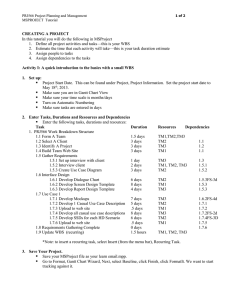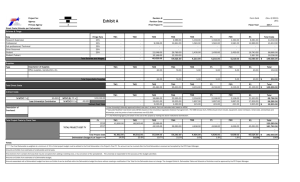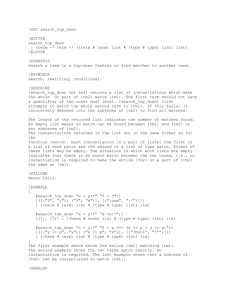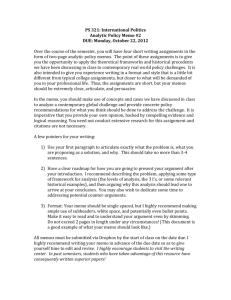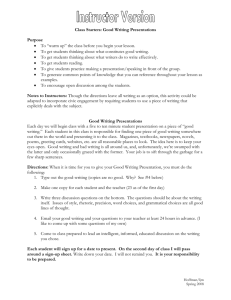MOR 421 Social and Ethical Issues in Business
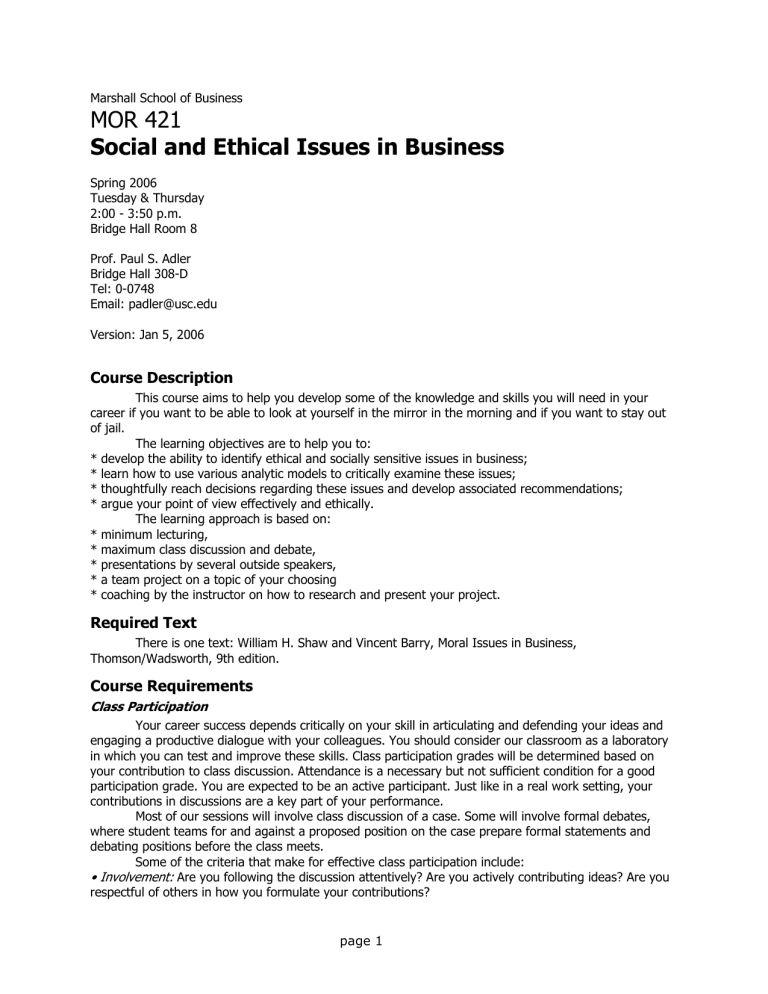
Marshall School of Business
MOR 421
Social and Ethical Issues in Business
Spring 2006
Tuesday & Thursday
2:00 - 3:50 p.m.
Bridge Hall Room 8
Prof. Paul S. Adler
Bridge Hall 308-D
Tel: 0-0748
Email: padler@usc.edu
Version: Jan 5, 2006
Course Description
This course aims to help you develop some of the knowledge and skills you will need in your career if you want to be able to look at yourself in the mirror in the morning and if you want to stay out of jail.
The learning objectives are to help you to:
* develop the ability to identify ethical and socially sensitive issues in business;
* learn how to use various analytic models to critically examine these issues;
* thoughtfully reach decisions regarding these issues and develop associated recommendations;
* argue your point of view effectively and ethically.
The learning approach is based on:
* minimum lecturing,
* maximum class discussion and debate,
* presentations by several outside speakers,
* a team project on a topic of your choosing
* coaching by the instructor on how to research and present your project.
Required Text
There is one text: William H. Shaw and Vincent Barry, Moral Issues in Business,
Thomson/Wadsworth, 9th edition.
Course Requirements
Class Participation
Your career success depends critically on your skill in articulating and defending your ideas and engaging a productive dialogue with your colleagues. You should consider our classroom as a laboratory in which you can test and improve these skills. Class participation grades will be determined based on your contribution to class discussion. Attendance is a necessary but not sufficient condition for a good participation grade. You are expected to be an active participant. Just like in a real work setting, your contributions in discussions are a key part of your performance.
Most of our sessions will involve class discussion of a case. Some will involve formal debates, where student teams for and against a proposed position on the case prepare formal statements and debating positions before the class meets.
Some of the criteria that make for effective class participation include:
• Involvement: Are you following the discussion attentively? Are you actively contributing ideas? Are you respectful of others in how you formulate your contributions? page 1
• Listening: Are you a good listener? Are your points relevant to the flow of the discussion? Do you link them to the comments made by others?
• Adding value: Do your comments show evidence of insightful analysis? Do they make use of relevant experience? Are they formulated in a succinct, effective manner? Do your comments clarify and highlight the important aspects of earlier ideas and lead to a clearer statement of the relevant concepts and issues?
• Risk-taking: Are you willing to test new ideas, or are all your comments “safe”? (For example, repeating information from the readings and cases without analysis or conclusions, or offering simply generic statements that would be true in almost any setting.) Do your comments raise “difficult” questions that challenge us to think more deeply?
At the end of each discussion session, I will assign a score to each student on the following scale:
0: absent
1: present with no or minimal participation
2: modest participation: comments that help flesh out a given part of the analysis/discussion
3: good participation: comments that clarify complex issues, synthesize material, and move the discussion forward noticeably
4: excellent participation: comments that challenge constructively the direction of the discussion and reorient it in a productive way.
Note 1: Since during class I may call on students at any time, please avoid embarrassment by telling me before class if you are not prepared.
Note 2: if you are uncomfortable with class participation, please let me know at the beginning of term and I will work with you to help you overcome this barrier.
Note 2: Much of the learning in this course happens in class. Attendance is therefore a requirement. Missing more than 2 class sessions will normally result in a grade reduction. Missing class without notifying me in advance is, absent dire necessity, simply rude.
Assigned Readings and Case Studies, Weekly Case Memos
You will be expected to complete all assigned readings and case studies. Your mastery of this material will significantly impact your participation grade.
Most weeks we have two cases to discuss: in these weeks, you need to submit a written memo on either the two cases -- choose whichever one you prefer to discuss. The memo should answer all the
Discussion questions at the end of the case. It should be about 2 pages (single spaced). In reading these memos, I am not concerned about the beauty of your writing: point form rather than prose is good enough: but I do want to see what you think about the case and the Discussion questions. On at least one of these discussion questions, you need to lay out the arguments for two contrasting points of view and argue for your preferred point of view.
In lieu of a mid-term exam, you will need to prepare a slightly more substantial case memo on the case discussed on either Feb 28 or March 2 (your choice). These memos should be approx. 5 pages in length. This will give you and I an opportunity to see if you are “getting it.” It will also be good practice for the final exam, since the exam will be a case study and associated discussion questions similar to these.
Group Projects
At the beginning of the semester you will form working groups of 3-4 students/group. These groups will work together to complete a research project and class presentation on a topic of your choosing. You have broad latitude in your choice of a project -- but you do need my approval for the topic. Projects might focus on issues such as:
* AIDS drug policy for Africa
* CitiGroup and sub-prime lending
* Walmart’s labor practices
* Mad cow disease in the U.S.
In your project, you will:
9 identify the stakeholders and their interests;
9 identify the ethical issues clearly; page 2
9 identify and describe the major social, economic, and/or legal factors that impact the issue;
9 analyze the available options; and
9 propose and defend a resolution.
Each group will make two presentations on their project to the entire class, one in the form of a progress report and the other at the end of the term. I will also meet with each group to review a roughcut of their final report. The final deliverable is the oral report plus a “talking document” -- this is described in more detail in the Appendix.
Final examination
The final exam will be a case study, similar to the ones we have discussed in class.
Grading
•
Grading will be based on the following components:
Participation 10%
• Debate performance 5%
• Weekly written case memos 10%
• Mid-term written case memo 10%
• Project update 10%
• Project rough-cut presentation 10%
• Project final presentation
• Final Exam
30%
15%
Notes
Academic integrity is a critical value of the University community. Integrity violations destroy the fabric of a learning community and the spirit of inquiry that is vital to the effectiveness of the
University. Academic integrity policies, the description of prohibited behavior, and the appropriate sanctions are described in the current edition of SCAMPUS.
Students with disabilities: Any student requesting academic accommodations based on a disability is required to register with Disability Services and Programs (DSP) each semester. A letter of verification for approved accommodations can be obtained from DSP. Please be sure the letter is delivered to the instructor as early in the semester as possible. DSP is located in STU 301 and is open from 8:30 am to 5:00 pm, Monday through Friday. The phone number of DSP is (213) 740-0776.
Returned paperwork , unclaimed by a student, will be discarded after four weeks and hence, will not be available should a grade appeal be pursued by a student following receipt of his/her course grade.
page 3
Course Schedule
January 10
January 12
Introduction
Form groups
The nature of morality (1):
Shaw and Barry (S&B) Ch. 1: pp. 2-28,
Case 1.1: Made in the USA--Dumped in Brazil, Africa, Iraq…
January 17 The nature of morality (2):
S&B Ch. 1: Case 1.2: The A7D Affair.
Robert C. Solomon: It's Good Business .
January 19 Normative theories of ethics (1):
S&B Ch. 2: pp. 55-82
Case 2.1: Baby M.
Sign-up for group projects
January 24 Normative theories of ethics (2):
S&B Ch. 2: Case 2.2: The Ford Pinto.
James Rachels: What Would a Satisfactory Moral Theory Be Like?
January 26 Justice and economic distribution (1):
S&B Ch. 3: pp. 101-123
Case 3.1: What Ever Happened to the Steel Industry?
January 31 Justice and economic distribution (2):
S&B Ch. 3: Case 3.3: Poverty in America.
D.W. Haslett: Is Inheritance Justified?
February 2 no class
February 7 The nature of capitalism (1):
S&B Ch. 4: pp. 150-169
Ian Maitland: The Great Non-Debate Over International Sweatshops.
February 9 The nature of capitalism (2):
Amartya Sen: Markets and the Role of Ethics in Capitalism.
ELC session on Seafort/Cohoes Textile
February 14 Corporations (1):
S&B Ch. 5: pp. 204-226
Case 5.1: Exxon and Captain Hazelwood.
February 16 Corporations (2):
Case 5.2 Living and dying with asbestos
J. Cassidy: The greed cycle: How corporate America went out of control
February 21 The workplace: Basic issues (1):
S&B Ch. 6: Case 6.3: Speaking out about malt
Patricia H. Werhane and Tara J. Radin: Employment at Will and Due Process. page 4
February 23 The workplace: Basic issues (2):
S&B Ch. 6: pp. 276-298
Case 6.1: Burger Beefs
February 28 The workplace: Today’s challenges (1):
March 2
S&B Ch. 7: pp. 325-345
Case 7.3: She snoops to conquer
The workplace: Today’s challenges (2):
S&B Ch. 7: Case 7.5: The Mommy Track.
Claudia Mills: Workplace Wars: How Much Should I Be Required to Meet the Needs of
Your Children?
March 7
March 9
Spring break
March 21
Research updates on group projects
Research updates on group projects
Moral choices facing employees (1):
S&B Ch. 8: pp. 387-407
Case 8.1: Changing Jobs and Changing Loyalties
March 23 Moral choices facing employees (2):
S&B Ch. 8: Case 8.2: Profiting on Columns Prior to Publication.
Jennifer Moore: What Is Really Unethical About Insider Trading?
March 28 Job discrimination (1):
March 30
S&B Ch. 9: pp. 453-472
Case 9.4: Consenting to Sexual Harassment.
Job discrimination (2):
S&B Ch. 9: Case 9.1: Minority Set-Asides.
April 4
April 6
Richard Wasserstrom: A Defense of Programs of Preferential Treatment.
Workshop on rough-cut presentations of group project reports
April 11 Consumers (1):
Workshop on rough-cut presentations of group project reports
S&B Ch. 10: pp. 506-533
Case 10.2: Hot Coffee at McDonald's
April 13 Consumers (2):
April 18
S&B Ch. 10: Case 10.5: Closing the deal
Michael J. Phillips: The Inconclusive Ethical Case Against Manipulative Advertising.
The environment (1):
S&B Ch. 11: pp. 567-586,
Case 11.1: Hazardous Homes in Herculaneum.
April 20 The environment (2):
S&B Ch. 11: Case 11.2: Poverty and Pollution. page 5
April 25
April 27
W. Michael Hoffman: Business and Environmental Ethics.
Group Project Presentations
Group Project Presentations page 6
Program for March 7 and 9
The goal on these days is to (a) give you an opportunity to pull together a "preliminary assessment", (b) bring the class up to date on what you have learned, (c) give us an opportunity to challenge your thinking.
I realize that these are just "interim reports" so there may well be gaps where you simply haven't had a chance to do the research or do your analysis yet. But by trying to do as polished a presentation as you can, you will see where the gaps are more clearly.
Each team will get 15 minute for their oral presentation -- that's a firm time limit! You may find you have too much material to cover in just 15 minutes -- but this limit will force you to think about what's most important in what you want to say.
Then we'll have 15 minutes for Q&A from the audience.
You should use Powerpoint Slides and bring Notes handouts for the class. Your handouts can include charts, data, whatever backup material you think will be helpful to us. In your Ppt presentation, since this is just an interim report, it's ok for you to have a couple of "placeholder" slides -- i.e. ones were you say,
"This is where we plan to discuss x, y, z, but haven't got the material ready yet..."
Here is a general outline:
1. Summary: the main issue and your proposed solution
2. The relevant facts
3. The key stakeholders
4. The significant rights, interests and issues (legal, economic, social, moral/ethical) for each stakeholder
5. The main options for resolving the problem
6. The significance of the various options for the various stakeholders: how are their rights and concerns affected?
7. Recommendation and rationale for this recommendation
Some observations:
1. the main issue: it's often not easy to identify the main issue: people will have different opinions on how to define the "real issue" at stake in any given problem area. For example, with Social Security debate right now, is the main issue the imminent collapse of the system (per Pres. Bush)? or is it whether government should be taking care of people vs leaving people responsible for themselves? Deciding what the real issue is -- and convincing us that your characterization is correct -- may require of you some analysis of the facts (step 2).
2. the relevant facts: your view of the relevant facts might change as you get to the later parts of the analysis
3. stakeholders are any people affected by the issue: sometimes, some stakeholders may not be obvious at first sight -- they may be people far “downstream” or “upstream.”
5. options: there are often many possible options: focus on the plausible ones -- not bogus ones. And it's usually important for the clarity of your argument that you identify just 2, or 3,or at most 4 main ones -- that's not always easy to do: the main ones are the ones that are most strongly contrasting rather than just minor variants of each other. page 7
6. assessing significance of the options: You might end up with a chart that lists the options in the columns and assesses their merit in terms of the various concerns -- rights, costs, etc, -- that the stakeholders have
7. select an option and make your argument: This is usually the hardest part of the presentation: it's easy to tell us what you think should be done, but the hard part is convincing us that any reasonable person should agree with you!! page 8
Program for April 5 and 7
* each team only needs to come to one of these two days, April 5 or April 7 -- the other day, you will have free; you can email me at your convenience to tell me which date you prefer and I will try to accommodate your preferences;
* each day, each team will have about 45 minutes: 15 minutes to present, and 30 minutes for follow-up
Q&A and discussion with the audience. This will be video-taped. Each team will take their video-tape with them at the end of the session.
* after each team's 45 minutes, the students in the audience and I will all do written evaluations on both the content and the form. I will collect these evaluations at the end of the session.
* after the workshop session, each team needs to review their video-tape and write their own evaluation of their presentation form.
* I will meet with each team for one hour some time in the week following the presentations. I have considerable flexibility, but we will need to find time slots that work for your whole team and for me. I will send out a schedule.
* to this follow-up meeting, your team should bring along the video, your self-evaluation form, and hardcopy of your presentation materials. During the meeting, I will feed back to you a synthesis of the audience evaluations and my own suggestions for improvement; I will brainstorm with you what your can do to make your final presentations as solid, interesting, and convincing as possible. page 9
Deliverables for the final presentation
Apart from the oral presentation, each team has three deliverables:
1. a “Talking Document” composed of the PowerPoint Slides with accompanying Notes plus Appendices,
2. a handout of this Talking Document, and
3. a "Memo" that puts in prose form the basic argument of your Presentation -- in about 5 pages.
To expand on this:
1. Your Talking Document is composed of:
* ppt Slides: you all know a lot about how to compose good slides (remember the Goldilocks rules: not too much content, nor too little)
* Notes: where the Slide bullet points are not self-explanatory, Notes are important. Goldilocks is relevant here too: In your Notes, we want neither too much nor too little detail. Not too much, because during the presentation, you don't want your audience distracted, with their heads down reading your Notes. But not too little, because in the real world, it's quite possible that your materials will circulate to other people after your presentation meeting, and you'd like people who didn't attend the meeting to be able to follow the argument that you are making with each slide. These Notes should not be your voice-over script and should not be a prose report in disguise: they should simply add, in bullet point form, whatever extra information the reader would need to understand the points being made on the Slide.
* You will probably also want to include Appendices that show any backup analysis you performed or data you collected. (Not a data dump!)
2. a Handout: please be ready to give everyone in the audience a copy of your “Talking document”
(Slides, Notes, and Appendices) at the beginning of your presentation. This does not need to be an expensively produced (color, bound, etc) handout -- something simple (black and white, stapled) will do fine.
3. a memo: in about 4-5 pages single-spaced, you should be able to lay out the key points of your argument. You can refer people to the Talking Document appendices for the data underlying your assertions. But apart from that, the memo should be able to stand alone: i.e. reading it should be a good substitute for being at the presentation meeting. page 10
MOR 421
Grading Sheet
* The issue: Has the team identified and clearly defined a “root” issue?
* Have they identified a root issue that underlies the “presenting symptoms”?
* Have they made a compelling case that this is indeed the root issue?
* The stakeholders:
* Has the team identified the relevant stakeholders?
* Has the team identified the “stakes” (rights, concerns) that each stakeholder has in the issue?
* The alternatives:
* Has the team identified a good range of possible solutions to the problem?
* Has the team analyzed these alternatives’ pros and cons from all the relevant ethical and social
perspectives?
* The recommendation:
* Has the team made a reasoned argument for its preferred solution?
* Has the team explained in sufficient detail how its preferred solution can be implemented?
(Detail enough to convince us that it will address the root issue effectively)
* The presentation:
* Does the argument flow in logical way?
* Is the oral presentation engaging?
* Are audio-visual materials used to good effect?
* Is the Talking document well crafted? page 11
MOR 421
Peer Evaluation Form
Please use the following scale to rate your team members and yourself:
F: Seriously deficient
C: Weak
B. Good
A. Excellent
Please use the back of the form to provide any supporting narrative that would help illustrate notable strengths or weaknesses and that would justify an unusually high or low evaluation.
Team member (TM) name (you are team member #1):
TM1: <your name>
Evaluations:
TM2: TM3: TM4
Preparation: Rate the extent to which the member completed the necessary assignments, had read the related material, and was ready to contribute to the team. Ratings for each team member:
TM1:
Input: Rate the extent to which the member provided valuable input of ideas towards the team’s work.
Ratings for each team member:
TM1:
Diligence: Rate the extent to which the member took on the necessary roles to complete the team’s work, their timeliness in completing and distributing work, and the quality of the work performed. Ratings for each team member:
TM1:
Facilitation: Rate the extent to which the member helped the team maintain a positive climate and work together effectively. Ratings for each team member:
TM1: page 12

